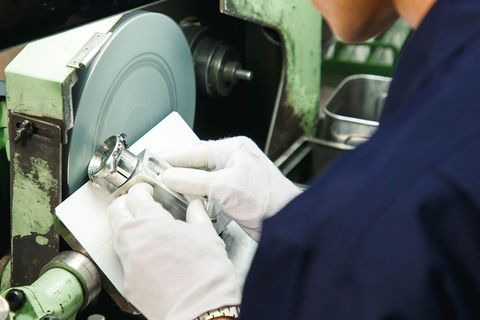You can see your face reflected in the case of a Grand Seiko as if you're looking in a mirror.
With its resultant impeccably sharp edges, this refined finishing is one of the factors that makes the Japanese brand special. Enthusiasts are enthralled not only by the visual effect, but also by the story of a technique originating in 10th-century samurai sword polishing called zaratsu. It's seductive luxury storytelling...but, unfortunately, it's bullshit.
The genesis of the zaratsu myth related to Japanese sword polishing is unclear, but it circulated in reportage and went unquestioned for years (even the watch world can't escape "fake news"). It's only relatively recently that the narrative started to change. While Grand Seiko's impressive quality should stand on its own, the real story isn't quite as exotic — though the skill and craftsmanship behind GS's lauded products is quite legitimate.
As it turns out, the word zaratsu is a Japanese transliteration of the German name Sallaz, meant to reflect the German pronunciation. The Swiss company Gebrüder Sallaz ("Sallaz Brothers") made a polishing machine that Seiko purchased in the 1950s for their Hayashi Seiki facilities. The machine was marked with Gebr.Sallaz, and workers began referring to the finishing process achieved with the machine as "zaratsu." The term in this form is, therefore, internal to Seiko only.
While the process is most associated with Seiko and Grand Seiko, it's not exclusive to those companies. The same machines and techniques are used by other Japanese brands in their higher-end offerings, such as Citizen and even Casio in its G-Shock MR-G range, as well as the independent brand Minase. (These brands often refer to the technique as Sallaz.) High-end European watches commonly achieve a similar effect with different techniques, variously called "black polishing," "mirror polishing" or "block polishing."
Zaratsu polishing (or whatever you'd like to call it) is performed by hand on one case at a time by skilled workers using the side of the polishing wheel, rather than the front. It requires the polisher to apply the right amount of pressure for the right amount of time at the right spot on the wheel, all of which is judged visually and tactilely. It takes months to master the requisite intuitive sense, according to Seiko polishing specialist Yuji Kuroki. It's not only highly difficult to polish a surface evenly, but also to ensure that it's consistent with other surfaces on the rest of the case.
Why go to all the trouble? The goal is twofold: to eliminate distortions in the polished surface, as would occur with lesser polishing techniques, and to create a fine, sharp edge — especially noticeable where two surfaces with contrasting finishes meet. Together, these elements create a stunning effect that makes a product smack of overall quality and refinement. It's not only the shiny, reflective surfaces that get the treatment, however: parts of the case with brushed finishes also receive zaratsu polishing in order to make sure the hairline texture is perfectly even.
These features are found across Grand Seiko products as well as in certain Seiko watches. The refined finishing might be as beautiful as that of a katana, and the expertise involved might be comparable — but it's the quality you want to be paying for, rather than a fanciful story.
This content is created and maintained by a third party, and imported onto this page to help users provide their email addresses. You may be able to find more information about this and similar content at piano.io
The Link LonkJuly 23, 2020 at 06:31PM
https://ift.tt/3jINuTM
What You Need to Know About Seiko's Famously Perfect Watch Finishing - Gear Patrol
https://ift.tt/2Ahe7gw
Seiko

:no_upscale()/cdn.vox-cdn.com/uploads/chorus_asset/file/22689672/lil_baby_drake_rolex.jpg)
No comments:
Post a Comment